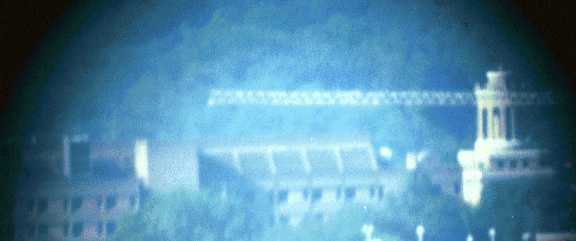Transit of Venus - Pre Event Test Photographs
Kavan Ratnatunga, Carnegie Mellon University, Pittsburgh, USA.

Kavan Ratnatunga, Carnegie Mellon University, Pittsburgh, USA.

The First thing I discovered was that someone had dropped the TOPCON camera and the lever to wind the film forward had broken, and the shutter did not work. I took it over to Bernie's photo-shop to service and a few days later I got the bad news that since TOPCON a leading manufacture in the 1960's no longer existed and parts for the repair could not be obtained. They however offered to sell me an used TOPCON body which although not the same model should fit the adaptor to the telescope. I was worried that the view finder in the new camera body was not of the Eyepiece type used for Astrophotography. But that part was removable and could be replaced with the Eyepiece type view finder from the old camera. The Camera problem was solved.
The AstroGroup at CMU Physics Dept has eight 3.5-inch Questa Telescopes. However after years of student usage of these classic telescopes, the collimation of few are bad leading to poor optics and some are not fully functional. So I borrowed Questa with CMU #4004 which I remember taking on last trip and had given me good results. I found it was difficult to point, the declination drive didn't lock and I really didn't understand what was wrong. So that evening I drove out to Wagman Observatory which was having a StarParty and met an Amateur Astronomer who owned a Questa and had used the CMU telescopes. He gave me the advice I needed. The declination had clamped locked and advised me to select a Questa which worked properly. He also reminded me of the full Solar Filter about which I had forgotten. So I went to pick out another Questa, only to discover that the #4004 was in-fact in a different case. Focusing on my apartment block visible 3-miles north from my CMU office window confirmed this Questa worked properly and had good Optics. Picture on top is of CMU and WEH taken from my Apartment, I remembered I needed the tripod I had been lazy carry on my Eclipse trip and had to improvise on a table.
Next I needed to do a test exposures to make sure the new camera worked properly and I could get good images of SunSpots. I first loaded a 200ASA film and took a series of exposures of the Sun with the telescope mounted at Prime Focus behind the Mirror. 1/1000, 1/500, 1/250, 1/125 seconds. Took some of Venus 1/60 and 1/30 and of the crescent Moon 1/60 second. I developed the Film and discovered that I had rewound the film the wrong way. The Photo-Shop operator explained what I had done wrong and the need to rewind the film the correctly to avoid streaking in the negative. The Venus had either double exposed or moved. I need to remember to wind the film forward fully after each exposure. The Sun was over exposed on all exposures other than the 1/1000 second which was the fastest I could do on this camera.
For the next test Roll I used 100ASA film. I was also advised to try taking photographs from the eyepiece mount as well as with the Barlow. The weather in Pittsburgh was rainy. I had to wait days for clear Sky to take photographs of the Sun, and there was hardly any days left. Friday was clear, I was leaving for Egypt the following Monday. This time I got the Photo-Shop to make we a CD of the photographs. The 35MM negatives are scanned at 1536x1024 i.e. 1000dpi or 25 micron pixels. These scans linked below give 3 arcsecond pixels. I probably need to get the negatives scanned at 2400 or 3000 dpi to get full image resolution from grain size of 100 ISO film (10 micron ?).
The 1/1000 second exposure was OK at Prime Focus. The image of the Sun was 588 pixels across with camera at Prime Focus and the exposure was OK. The Sun was 606 pixels across with camera at eyepiece mount with no Barlow. Only 3% larger than Prime Focus.

This small SunSpot group (#618) visible near the edge of the Sun on 29th May was each about 30 arcseconds in diameter with a gap of 60 arcseconds between them. Venus would fit within the Gap.
This group of Sunspots was not visible to the Unaided eye Filtered with #14 Welders Glass. I could not even see them through 7x50 Binoculars also filtered with a pair of #14 Welders Glass over the front of each objective. This setup will probably show Venus. I strongly doubt Venus will be visible with Eclipse Sunglasses being marketed for the event. I even fear that someone in frustration of not seeing Venus might use a pair of Binoculars in front of them and be instantly blinded.
The #14 Welders Glass gives 14 magnitudes of extinction and lets through only 1 part in 400,000 of the Sunlight. The Sun with a Brighness of -26.7 is dimmed to the Brighness of -12.7 which is the Brightness of the Full Moon. The Standard Welders Glass is #5 and is not sufficient for the task.
|
A properly filtered Telescope or Projection needs to be used to observe the
Transit of Venus Safely. Solar Filtering must be done BEFORE light enters any observing instrument |
Primary Links